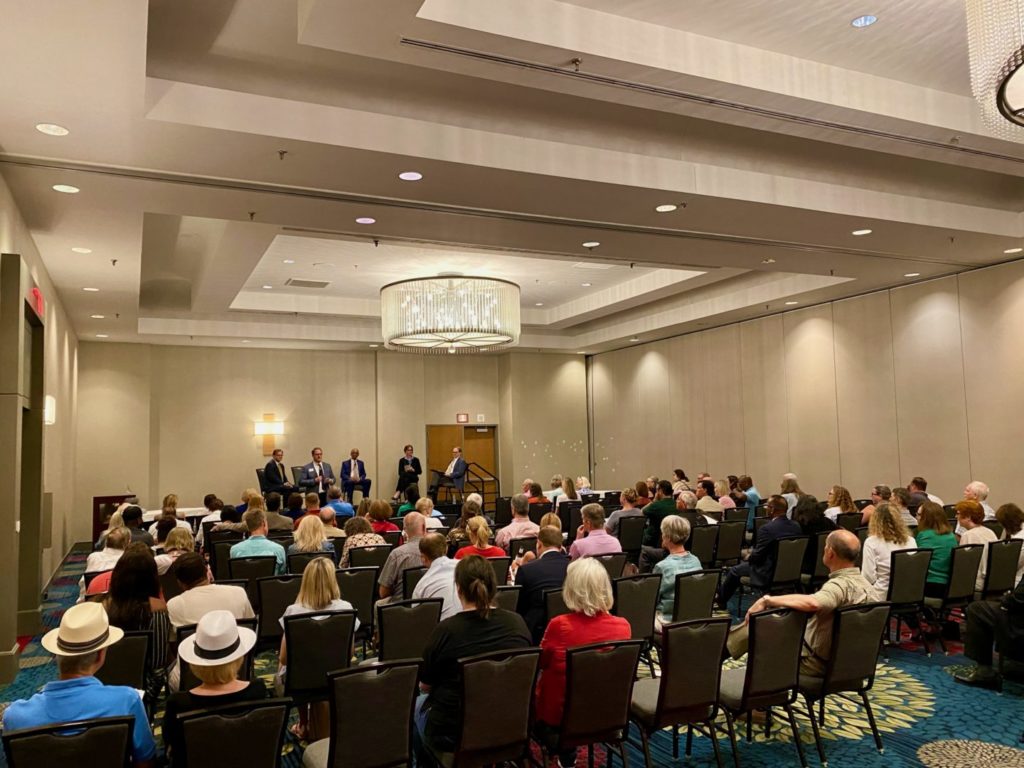National panel lays bare the radical race and sex agenda in America’s schools, offers solutions
As a rapt audience listened to a panel of experts explain the damage being done to schoolkids by radical far-left ideologies on race and gender, a lonely cry for help emerged from the crowd.
An…

As a rapt audience listened to a panel of experts explain the damage being done to schoolkids by radical far-left ideologies on race and gender, a lonely cry for help emerged from the crowd.
An anonymous high school sophomore, in the audience of concerned citizens at the event Monday in Kansas City, used a 3×5 card to tell the panel that although a well-adjusted varsity athlete, he’s afraid because of his gender and race. Afraid to voice his opinion anymore in a learning environment that increasingly looks upon his demographic unapprovingly.
He’s actually been “scolded” for offering his views, he says, asking the panel, “What can I do to be able to freely give my opinion without worry?”
And if examples like these – and concerns about divisive Critical Race Theory and the sexualization of the nation’s youngest schoolchildren – seem overblown, think again, says the panel of experts, who warn that these extreme ideologies are widespread and backed by powerful groups.
“These aren’t isolated incidents,” Mary Miller, of Parents Defending Education, tells The Lion. “We’re noticing that in most cases the new curriculum – and the new activism in the after-school clubs and the new training with the diversity directors – those things tend to be directed by some pretty large national activist groups. And they’re coming into schools in a systemic way.”
Miller, a mother of three and “accidental activist,” was one of four experts featured at the Kansas Policy Institute’s panel discussion, “The Cultural Divide Between Parents and Schools,” attended by over 100 concerned citizens, parents and school alumni.
Miller was joined on the panel by Dr. Robert Woodson, founder and president of The Woodson Center; Dr. Wilfred Reilly, a political science professor at Kentucky State University; and Dave Trabert, CEO of Kansas Policy Institute.
What is happening in schools?
So, what exactly is happening in schools? That’s the question panel moderator Michael Ryan, executive editor of The Lion and longtime journalist, began with. The answer, according to the animated panelists: Divisive, racist and sexualized content is being intentionally pushed on kids in schools all across the country.
Trabert referenced dozens of examples in Kansas alone, investigated by his organization’s publication, The Sentinel.
“We found a video of the diversity director at Shawnee Mission [School District] explaining why it’s really important for school systems to talk to kids about gender identity and transitioning to another gender as early as kindergarten,” Trabert said, referring to controversial comments from the district’s DEI director, Tyrone Bates.
Trabert also told of a Kansas parent in a biracial marriage who wrote to a state legislator “begging for help.” Her child came home from school wondering if one of her parents was good and the other, who was white, bad. The child’s trauma stemmed from a homework assignment asking elementary students to “write a sentence explaining why you’re sorry for being white,” Trabert recalled.
“This is all very divisive, deliberately so,” Trabert concluded. “The fact that the schools still insist that they don’t do it only underscores the intent to divide parents and students.”
Miller, whose organization gathers evidence of such shocking incidents from parents around the country, added that PDE has heard from many Kansas City parents about objectional curricula in their local schools, not to mention the many hundreds of examples they receive in schools all around the country. And it’s not only public schools. PDE made public controversial materials, and the outsized influence of race consultants, in one of Kansas City’s most elite private schools, Pembroke Hill.
How and why is it happening? From Marxism to COVID
Such radical teachings have been many decades in the making, panelists agreed, but have penetrated K-12 education largely in the past few years.
A perfect storm, beginning with the confluence of the Black Lives Matter movement, the death of George Floyd and the COVID-19 outbreak in 2020, led schools toward CRT-inspired activism, Miller noted.
Woodson and Reilly reached further back into American history to explain how such a storm was even possible.
In the 1960s, socialist intellectuals such as Richard Cloward and Frances Piven helped recruit black families into the welfare system, which then hamstrung them, causing many of the disparities and issues facing the black community today, Woodson said, including educational disparities.
Reilly, amplifying a point by Miller, said the roots of today’s radical race and sex agenda have long been embedded in Marxist doctrine – saying virtually every critical theory influencing the far-left teaching in schools today is just Marxism – anti-rich people – with a tweak.
“Virtually every critical theory is Marxism, with the ‘rich man’ replaced as the villain … by somebody else,” he said. “Critical Race Theory is the Marxist dynamic with the ‘rich man’ replaced by the ‘white man.’ Feminist theory is Marxism with the ‘rich man’ replaced with ‘the man’.”
Reilly also traced the modern radical agenda back to Jean-Jacques Rousseau’s concept of a “social contract.”
“The basic idea is that the ordinary institutions of society are kind of set up to oppress,” Reilly explained. The goal of those inspired by critical theories, he said, is to actively overturn ordinary institutions – including the family.
“There are basically three components to any critical theory,” Reilly went on. “One, society is set up to oppress whatever your group is – women, for example. Two, any gap in performance shows that oppression. … The third point is that the solution is equity.
“Equity does not mean equality. It means absolutely equal distribution of resources between winners and losers.”
In practice, the panel suggested, this explains why the left seeks to lower standards, do away with standardized testing and introduce other “equity” concepts into student evaluations in order to address achievement gaps between racial demographics of students.
Woodson pushed back on this approach, drawing on his own experience as a child before desegregation.
“Dumbing down standards doesn’t help black children,” Woodson declared. “There are two ways you can deny people from participating and competing. One is to deny them by law, like it was when I was a child.
“The second one, that is much more devastating, is to tell them that they don’t have to compete. Because of what happened to your ancestors in your past, all you have to do is just sit there at the gambler’s table and wait to be dealt a winning hand. And if white people don’t deal you a winning hand, it’s because they’re racist.”
Such misguided equity policies affect all children, regardless of the demographics to which they belong, Miller added.
“Schools have been listening to activists, consultants, national groups, their school association,” she said. “And it turns out, when parents start looking behind the curtain at who these groups are, they find out these individuals are preaching radical Marxist theories, radical gender theories.
“They’re talking about ‘queering’ a school in terms of gender ideology. They’re talking about infusing critical theories. … So children are missing out.”
Instead, schools should focus on doing their job, says Trabert. “Their primary job is to academically prepare kids for college and career,” he said, adding that the public education system “is not really designed to help students. It is designed to sustain and support the public education system, and the adults in the system.
“It’s not about the kids. Nothing changes. There is no accountability in the public education system. Achievement can go down. Gaps can get worse. Nothing happens. Money can be spent illegally – nothing happens.”
What can parents and others do about the problems in education?
As bleak as the current divisive and distracting radicalism in public education might be, the panel was hopeful, offering practical solutions.
Miller identified three areas for parents and citizens to focus on: policy, curriculum and activist influence.
First, she said, parents and alumni should push school boards for common-sense policies, such as restricting age-inappropriate and divisive material, a parents’ bill of rights, and statements on race-blind hiring.
Second, Miller suggests schools should choose more classical, liberal-arts curricula.
“If we look at any curriculum that’s been released in the last 10 years, its riddled with critical theory because the publishers and the [education] schools realize there’s money in it,” she said. “And adopting new curriculum also gives schools access to COVID relief funds.”
Finally, Miller warned that parents and alumni should ensure schools stay away from the influence of radical consultants and national activist groups attempting “to connect to children politically” through after-school clubs and the like.
Trabert seconded the need for consistent pressure.
“This system is not going to fix these problems on its own. There needs to be pressure from adults. There needs to be pressure from the legislature. The best thing the legislature can do is pass universal school choice” as in such states as Florida, Indiana and Illinois, he argued.
Woodson said it’s also important that leaders listen closely to local communities about their concerns and grievances.
Other practical suggestions also came in audience questions of the panel, including the notion that true freedom of thought requires community. Of the sophomore afraid to express his opinions because he’s a white male, Ryan opined:
“This young person is not guilty of anything other than cognitive deviance – believing differently than what you’re being told, or what the dominant culture is telling you. And it is hard to maintain cognitive deviance alone. You have to find others who believe like you, and be in clusters.”



